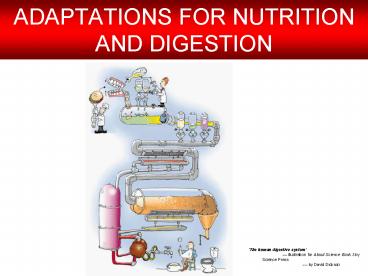ADAPTATIONS FOR NUTRITION AND DIGESTION - PowerPoint PPT Presentation
1 / 26
Title: ADAPTATIONS FOR NUTRITION AND DIGESTION
1
ADAPTATIONS FOR NUTRITION AND DIGESTION
'The human digestive system'
illustration for About Science Book 3 by
Science Press
----
by David Dickson
2
DIGESTION AND ABSORPTION
- For a nutrient to be used by cells of an
organism, it must pass through the cell
membranes. This process is called absorption. - The nutrient molecules in food are usually too
large to pass through cell membranes. Thus, to be
absorbed by the cells, most food molecules must
be broken down into smaller, simpler forms. The
process by which food molecules are broken down
is called digestion.
3
DIGESTION AND ABSORPTION
- MECHANICAL DIGESTION
- Pieces of food are first cut,crushed or, broken
into smaller particles without being changed
chemically - Mechanical break down increases the surface area
of food and prepares the food for faster chemical
digestion
4
DIGESTION AND ABSORPTION
- Examples for mechanical breakdown
- Cutting of food particles with teeth
- Emulsification
- Big oil small oil
- Droplets droplets
bile
5
Sudan III has been used to stain oil. The effect
of emulsification is shown below
6
Large oil drops are physically broken down into
numerous smaller oil droplets.
7
Numerous oil droplets are formed as a result of
emulsification.
8
Numerous oil droplets are physically formed as a
result of emulsification.
9
DIGESTION AND ABSORPTION
- 2.CHEMICAL DIGESTION
- It is carried out by digestive enzymes which act
only on the surface of the food particles. - Chemical digestion takes place in stages
- - large molecules are broken down into smaller
molecules - - smaller molecules are broken down into
digestive end products
10
DIGESTION AND ABSORPTION
Examples for chemical digestion lipid
fatty acids glycerol
lipase
11
NUTRITION IN PROTISTS
Intracellular digestion takes place in protists
12
(No Transcript)
13
(No Transcript)
14
NUTRITION IN HYDRA
15
NUTRITION IN HYDRA
DIGESTION IN HYDRA IS BOTH INTRACELLULAR AND
EXTRACELLULAR
16
NUTRITION IN PLANARIAN
The pharynx can suck small bits of food into the
digestive cavity. Most digestion takes place
within food vacuoles in the cells lining the
intestine.
17
Digested food diffuses to all cells of the body.
Indigestible materials are expelled through the
pharynx and mouth.
18
NUTRITION IN EARTHWORM
Food passes through it
Food is pulled into the mouth by muscular
pharynx
Storage chamber, gradually releases food into the
gizzard
Chrushes the food and mechanical break down
occur. By muscular movement , food and sand
grains crush each other.
19
NUTRITION IN EARTHWORM
Undigested materials and soil are removed through
the anus
Chemical digestion absorption take place
20
NUTRITION IN INSECTS
It has teeth like plates made of chitin and food
is ground in it
Wastes stored temporarily and water is absorbed
Food is stored temporarily
The dried wastes are eliminated
gizzard
Food is broken down by mechanically
Undigested material passes through intestine
Chemical digestion and absorption occurs
Secrete saliva and food is mixed with saliva in
mouth for chemical break down
21
NUTRITION IN BIRDS
http//www.biologycorner.com/resources/bird_anatom
y.jpg
22
NUTRITION IN BIRDS
Food is stored and softened.
First part of stomach. Food is partially digested
by gastric juice.
Second part of stomach, thick-walled and
muscular. May contaion small stones. Food is
ground up and thoroughly mixed with gastric
juice.
Digestion is completed, and nutrients are
absorbed into the blood stream.
http//numbat.murdoch.edu.au/Anatomy/avian/fig4.1.
GIF
23
(No Transcript)
24
The digestive systems of different mammals
reflect their diet
25
DIGESTION IN RUMINANTS
26
DIGESTION IN RUMINANTS

